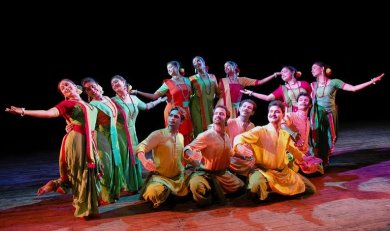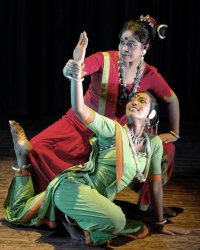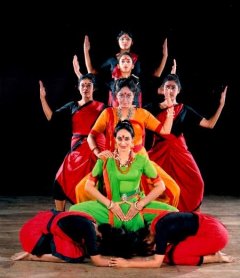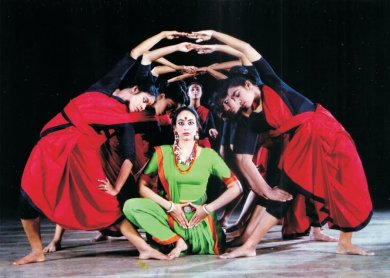
|   |

|   |
 e-mail: ukb7@rediffmail.com Of Earth, Earthy... Photos courtesy: Dancers Guild January 6, 2017 Manjushri Chaki Sircar, the ace scholar-choreographer-dancer from India and the USA, had always her feet firmly rooted to the ground. Born to dance and already dazzling the arts scene from her Presidency College days of the early 1950’s, she chose anthropology for her scholastic pursuit in Kolkata and New York, but dance remained in her genes. While researching on Lai Haraoba rites practiced in pre-Vaishnavite Manipur, she was struck by the myths of earth’s creation prevalent among its priests: the Maitis and Maibis, and began formalizing her dance language, Navanritya (new dance), for exploring a new body dynamic. Thoroughly down-to-earth, Navanritya became an organic synthesis of several traditional Indian dance forms: an amalgamation of classical moves (Bharatanatyam, Kathakali, Manipuri, Odissi), semi-classical forms (Mayurbhanj Chhau, Kandyan dance of Sri Lanka), folk forms and martial arts (Thang-ta, Kalaripayattu), blending them with earthy rituals, yoga and daily life gestures. In a sense, Manjushri (and later her highly gifted dancer-daughter, Ranjabati) sought to apply ancient tools to express modern day tensions. Under their dual inspiration, Navanritya evolved as a training method which helped dancers to de-construct traditional movements so that they could be used in a new context and still continue to draw on representational abhinaya as a pointer to motivation. With its roots in a variety of forms, mentioned above, and in textual traditions, Navanritya gained its ground as well as grammar. 

Tomari Matir Kanya (Daughter of your Earth), originally created by Manjushri and Ranjabati in 1983-85, was recently re-enacted by their talented group Dancers’ Guild from Kolkata, using Navanritya. Based on Tagore’s well-known prose-text and dance-drama Chandalika -- originally derived from the Buddhist tales of the Jatakas – Tomari Matir Kanya was located within the historical and social context of the ancient protest movement against Brahminic and patriarchic caste hierarchy that had been destroying the power of scriptural religion, to subordinate and marginalize women, especially the lower caste women. Manjushri – having been trained in the West by Martha Graham and Merce Cunningham – had innovatively infused an element of theatre in the dance-drama by interposing dialogues from the prose-text between the mother and the daughter. These conversations dramatically transcended the narrow space of the ‘private’ and acquired the nuances of a social commentary as well as a political statement: challenging the whole moral fabric of the patriarchy. Manjushri had once explained that she wished here to: • Emphasize the women’s agency as a force of social change. • Recognize the relative independence of lower caste women for performing ritual ceremonies that fall outside the Brahminic paradigm. • Underwrite the collective urge of oppressed castes and class to revolt. With the above intent, the presentation resonated with the call for feminist subversion. While the mother remained an isolated force with magical powers for invoking sorcery, the daughter became a banded group of untouchable women, brandishing the collective solidarity of her community. Using the Greek theatre’s concept of ‘chorus’, the clusters and ensembles of the female choir – in keeping with the tenets of Navanritya -- made a deep impression even where the ‘other’ persons from the upper castes appeared as disruptive intruders into their domain. 

With feminism as the cause celeb of the dance-drama, there was a clear accent on physicality, verging strongly on sensuality. In an explicit sequence on female sexuality, the mother pointed to her female organ, presumably proposing transfer of fertility and reproductive power to the daughter; the daughter went through a human tunnel as a prelude to her rite of passage and emerged triumphant, holding her female organ in hand. It was the most compelling -- albeit somewhat disconcerting -- sequence of an otherwise riveting evening. The daughter Ranjabati had enhanced her mother Manjushri’s vocabulary (both, alas, no more) of Navanritya and posed a few uncomfortable questions of her own, in the context of the prevailing training methods. First, she perceived that the classical dance pioneer, Rukmini Devi Arundale -- while re-defining dasiattam -- had ‘sanitized’ the form as well as the content of her evolved canons and virtually separated the dance from the dancer, leaving out the latter almost as an epitome of sensuality. Secondly, her highly formalized training process involved treating the upper part of the torso as quite distinct from the lower torso, as a result of which much of the dance movement was manifest in two dimensions and made the dancer put undue strain on her body. Lastly, the guru-shishya parampara of yore, so highly eulogized, was basically a heavily gender biased process of transmitting knowledge and skill: from the guru as ‘transmitter’ in a masculine penetrative form, on to the disciple as ‘subject’ in a feminine receptive form, very different from an interrogative and inquisitive methodology recommended everywhere else. Even treating Ranjabati as an enfant terrible of Indian dance, the fundamental doubts raised by her remain unresearched so far.  Dr. Utpal K Banerjee is a scholar-commentator on performing arts over last four decades. He has authored 23 books on Indian art and culture, and 10 on Tagore studies. He served IGNCA as National Project Director, was a Tagore Research Scholar and is recipient of Padma Shri. Post your comments Please provide your name and email id when you use the Anonymous profile in the blog to post a comment. All appropriate comments posted with name & email id in the blog will also be featured in the site. |